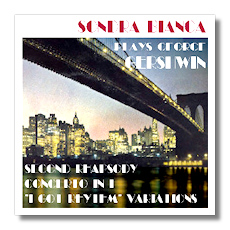
The Internet's Premier Classical Music Source
Related Links
- Gershwin Reviews
- Latest Reviews
- More Reviews
-
By Composer
-
Collections
DVD & Blu-ray
Books
Concert Reviews
Articles/Interviews
Software
Audio
Search Amazon
Recommended Links
Site News
 CD Review
CD Review
George Gershwin

Sondra Bianca Plays
- Second Rhapsody for Piano and Orchestra 1
- Piano Concerto in F 2
- Variations on "I Got Rhythm" 3
Sondra Bianca, piano
1 Pro Musica Symphony Orchestra of Hamburg/Hans-Jürgen Walther
2 Hamburg Radio Orchestra/Carl-Anton Bünte
3 New Symphony Society Orchestra/Walter Goehr
ReDiscovery RD-131 analog/monaural1 52:38
It is interesting to consider how many of the great classical pianists don't have Gershwin's Concerto in F in their repertoires. (Then again, it is surprising to consider some of the ones who do – Lazar Berman?!?) Is it considered inferior music? Too "poppy"? In the charming booklet note that accompanies this CD-R release, Sondra Bianca mentions that Gershwin's music was banned in Germany during the Nazi era. That would explain why some pianists don't play it, but what about all those other pianists, particularly the Americans of the recent past? Did Van Cliburn ever play this concerto? William Kapell? Byron Janis? If they did, they never recorded it.
Apparently Bianca was the first pianist to play the Concerto in F in Germany after World War II. She made something of a speciality of this work, and recorded it a total of three times. The recording presented here was made available on several budget LP labels, and credit was given to pseudonymous pianists. It is good to put Bianca's name to this recording, because in many ways it is excellent. It is one of the most playful to have come my way, and that playfulness extends particularly to Bianca's subtle games with the score's rhythms, which often are displaced just enough to remind us of Gershwin's connections with the world of jazz. The first movement is full of teasing moments, and Bianca's lively and sometimes unpredictable playing must have kept the members of the Hamburg Radio Orchestra on their collective toes. In the Finale, Bianca's fingers bounce off of the piano as if the keys were red hot. This is not the most muscular reading of the score, nor the most polished one, and the orchestral accompaniment is not very idiomatic. Still, Bianca's light-hearted playing – never overbearing, never quite what you expect – makes this a version almost anyone can enjoy.
The same holds true for the two shorter works. The "I Got Rhythm" Variations sometimes sound insubstantial, but conductor Goehr gives them backbone, and Bianca's contribution, while not as prominent as in the two other works, is kittenish. By the same token, the Second Rhapsody comes across as something more than the paler cousin of the Rhapsody in Blue. Hans-Jürgen Walther Bianca's frequent partner in concerts and recordings, really seems to be listening to the pianist, and the resulting dialogue between the piano and the orchestra adds freshness.
The Second Rhapsody is monaural, and there's some overloading at climaxes in the Concerto, but it is nothing over which to get too concerned. On the other hand, the sound in the "I Got Rhythm" Variations, while very forward, is broad-ranging – perhaps because it comes from a reel tape master. (I assume the sources for the other two selections were LPs.)
Several Bianca CD-Rs have been released by ReDiscovery; all are worth exploring. This one is available from www.rediscovery.us for $15, which includes shipping and handling.
Copyright © 2008 by Raymond Tuttle












